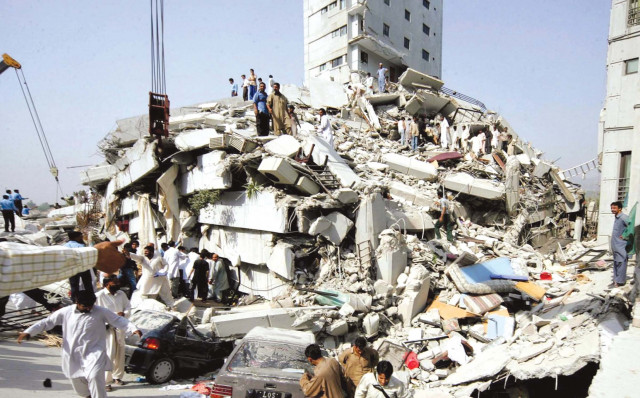Coping with disasters: Capital’s posh sectors most vulnerable to quakes
The ground will be swept under your feet if building code not followed, says expert.

The federal capital falls on the most active fault line with the seismic hazard varying from sector to sector, says a research paper.
Conducted by a group of researchers from two leading universities of the country, the paper calls for an updated building code to avoid human and material damages.
“Unless the building code are updated and implemented by the authorities concerned, the capital will continue to be at high risk,” says the research paper, titled “Probabilistic Seismic Hazard Analysis of Islamabad,” conducted by a team of researchers from National University of Science and Technology (NUST), Shah Abdul Latif University, Khairpur, Pakistan Meteorological Department. The research report has been published in the ‘Journal of Asian Earth Sciences’ recently.
The city’s posh sectors are prone to seismic threat, F-11 being the most exposed with a peak ground acceleration (PGA) value of 3.72 magnitude, says the report.
The report says that an earthquake of 6.2 magnitude on the Richter scale at a distance of 20-30km is most likely to hit Islamabad. The research further elaborates that even though 90 per cent of the earthquakes in the region are shallow (surface level), caused by the thrust fault mechanism, these small magnitude tremors can also prove to be dangerous.
Talking to The Express Tribune, Dr Abdul Qadir Bhatti, Assistant Professor, School of Earthquake Engineering, NUST, Islamabad, who has supervised the research, emphasized on updating the building code (the standard rules for construction of buildings), an essential measure to reduce damages in case of high intensity earthquakes.
“If the building code are updated and strictly enforced, then even an earthquake of 8-9 magnitude on the Richter can be sustained,” he maintained. However, he said that there was no chance of an earthquake of more than 8 magnitude in these zones.
Dr Bhatti claimed that the building code in the country have not been updated since 2007. He said there is a need of including ‘Seismic Retrofitting’ in the building code for improving the structure of old buildings, through different methods which are mostly followed by countries such as Japan, China and Indonesia.
He said that according to the new standard of building, the size of the foundation column should be 18”x18” instead of 12”x12”. Though CDA has its building code, it needs to be updated, the researcher exhorted.
However, Deputy Director General CDA Building Control Authority Malik Ghulam Murtaza, when contacted, claimed that the civic authority has adopted new building code. Dismissing the notion of it being outdated, he said, “If the existing building code is followed highrises and other structures can sustain an earthquake with an intensity of 8-9 magnitude,” he maintained.
He added that CDA has adopted the Seismic Code of 2007 and all the buildings are designed according to it. Murtaza said as Islamabad falls in Zone1-B and is vulnerable to earthquakes at all times, CDA has shortlisted 18 professional firms for designing buildings and for construction material selection. Murtaza added that CDA is strictly monitoring the construction of government and private buildings and the people have also become cautious after the 2005 earthquake that killed more than 70 people when a multi-storey building, Margalla Towers in F-10 sector partially collapsed.
Referring to Margalla Tower tragedy, Bhatti said the building’s material and column size were not as per standard.
The doctor said that Karachi also falls in the seismic fault zone and faces the risk of a tsunami due to its’ close proximity to the sea, therefore, it is imperative that building code is followed strictly.
Pakistan Housing Authority Additional Director-general Muhammad Irfan told the Express Tribune that the Housing Ministry has made a comprehensive building code by taking all the stakeholders onboard. “Now it only remains to be enforced and it should be enforced strictly,” he stressed.
Such findings coincide with the fact that Pakistan is prone to seismic activity and Islamabad is located very close to the Main Boundary Thrust (MBT). The 2005 earthquake in Azad Kashmir and its’ surrounding regions is a glaring example of the threat that the northern part of the country faces, especially in absence of necessary measures for coping with natural disasters.
Published in The Express Tribune, August 22nd, 2011.



















COMMENTS
Comments are moderated and generally will be posted if they are on-topic and not abusive.
For more information, please see our Comments FAQ